Eliza Knight's Blog, page 57
April 4, 2012
Historical Romance Review: To Wed a Wild Lord by Sabrina Jeffries
 Ms. Jeffries is a master at creating conflict that keeps readers on the edge of their seats, and To Wed a Wild Lord is no different. There were moments in this book that I just wasn't sure if Virginia and Gabriel would end up together...
Ms. Jeffries is a master at creating conflict that keeps readers on the edge of their seats, and To Wed a Wild Lord is no different. There were moments in this book that I just wasn't sure if Virginia and Gabriel would end up together...
ABOUT THE BOOK
From the Hellions of Halstead Hall series...
Drowning in guilt over his best friend's death seven years ago, Lord Gabriel Sharpe, the Angel of Death, knows his only hope at redemption is a race against a shocking opponent.Shrouded in darkness for the past seven years, the infamous racer Lord Gabriel Sharpe is known to accept every challenge to race thrown at him. When his next challenge comes in the form of his late best friend's sister, Virginia Waverly, Gabe is shocked. Yet she presents just the opportunity Gabe needs—marriage to fulfill his grandmother's ultimatum and ensure his inheritance. What he didn't count on was needing her love.
MY REVIEW
I absolutely adored the School for Heiresses series by Ms. Jeffries, and I hadn't yet had a chance to read a book in her newest series, Hellions of Halstead Hall, so when To Wed a Wild Lord graced my mailbox, I was totally psyched! And it didn't disappoint. I've already ordered the previous three books and the 5th which came out a couple months ago. There just aren't enough hours in a day--so it took me two evenings to read this book. But I digress...Our heroine Virginia Waverly has suffered the past seven years over the sudden death of her brother, who was racing none other than Lord Gabriel Sharpe--the Angel of Death, a nickname given after the death of Roger Waverly. She wants her revenge and a chance to beat the bad boy lord at his own game, so she challenges him to a race.The problem? He feels an immeasurable amount of guilt over the death of his best friend, Roger, and wants to make ammends by marrying Virginia.They make a wager--but that wager ends in a battle of wits, wills, love and the discovery of themselves and each other--and a number of conflicts along the way!I highly recommend this book, and I can't wait to read the rest of the series!
Published on April 04, 2012 06:02
April 3, 2012
Guest Author Jack Caldwell (and Giveaway of THE THREE COLONELS – Jane Austen's Fighting Men!)
Welcome back to History Undressed, guest author Jack Caldwell. I adore Jack's work. He is an amazing author and has put some fantastic spins on Jane Austen fanfic! Today he's entertaining us with a bit of Regency history. Enjoy! Leave a comment for a chance to win Jack's new release, The Three Colonels.
 Greetings, fellowhistory lovers! Jack Caldwell here, author of THE THREE COLONELS – JaneAusten's Fighting Men, the epic, romantic sequel to Pride & Prejudice and Sense & Sensibility, fromSourcebooks Landmark.I take the critical event ofthe Regency period in English history—theHundred Days Crisis—and throw some of literature's most beloved charactersinto that maelstrom. In other words, I send some of Austen's military figuresto Waterloo. From S&S are Marianneand Colonel Brandon, Elinor and Edward Ferrars, and John Willoughby. FromP&P are Colonel Fitzwilliam, Anne deBourgh, Lady Catherine, Fitzwilliam and Elizabeth Darcy, the Collinses,Wickham, Denny, and Caroline Bingley. I have original characters, like Colonel Sir John Buford, and theyinteract with historical figures, such as Wellingtonand Napoleon.
Greetings, fellowhistory lovers! Jack Caldwell here, author of THE THREE COLONELS – JaneAusten's Fighting Men, the epic, romantic sequel to Pride & Prejudice and Sense & Sensibility, fromSourcebooks Landmark.I take the critical event ofthe Regency period in English history—theHundred Days Crisis—and throw some of literature's most beloved charactersinto that maelstrom. In other words, I send some of Austen's military figuresto Waterloo. From S&S are Marianneand Colonel Brandon, Elinor and Edward Ferrars, and John Willoughby. FromP&P are Colonel Fitzwilliam, Anne deBourgh, Lady Catherine, Fitzwilliam and Elizabeth Darcy, the Collinses,Wickham, Denny, and Caroline Bingley. I have original characters, like Colonel Sir John Buford, and theyinteract with historical figures, such as Wellingtonand Napoleon.
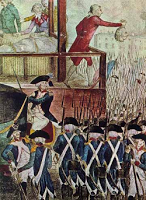 Please allow me a briefexplanation as to why Waterloo was so critical a moment in history. Since 1792,most of Europe had been at war against the armies of the French Revolution. Thehomicidal fanatics of the Revolution wanted to spread the ideas of liberté, égalité, fraternité—and "Madame Guillotine"—across thecontinent and England. The crowned heads of Europe and the Parliamentarykingdom of Great Britain felt the threat and tried to extinguish RevolutionaryFrance. Enthused with zeal, the French armies fought well against the might ofvarious Coalitions and was able to expand France into the Low Countries whileholding off for a time the forces organized against it.
Please allow me a briefexplanation as to why Waterloo was so critical a moment in history. Since 1792,most of Europe had been at war against the armies of the French Revolution. Thehomicidal fanatics of the Revolution wanted to spread the ideas of liberté, égalité, fraternité—and "Madame Guillotine"—across thecontinent and England. The crowned heads of Europe and the Parliamentarykingdom of Great Britain felt the threat and tried to extinguish RevolutionaryFrance. Enthused with zeal, the French armies fought well against the might ofvarious Coalitions and was able to expand France into the Low Countries whileholding off for a time the forces organized against it.
 The Republic couldn'thold—bad generalship externally and political instability internally broughtthe nation to the abyss. Then a heroic figure emerged—General Napoleon Bonaparte, a Corsican-turned-Frenchman, saved theFrench Army. He, with others, then conducted a coup in 1799, establishing agovernment run by three consuls, and Bonaparte became First Consul. Thebrilliant and ruthless general ended the revolutionary wars and, within a fewyears, maneuvered to rid himself of his fellow consuls. In 1804, he crownedhimself Emperor of France.General Bonaparte had wonadmiration for his reforms in France and respect for his abilities on thebattlefield, However, Emperor Napoleon Iwas something else entirely. Bonaparte was not of any royal house; he was acommoner. The crowned heads of Europe shook again. A commoner dared makehimself a king? Preposterous! Why, something like that might give ambitious menall over the continent ideas!
The Republic couldn'thold—bad generalship externally and political instability internally broughtthe nation to the abyss. Then a heroic figure emerged—General Napoleon Bonaparte, a Corsican-turned-Frenchman, saved theFrench Army. He, with others, then conducted a coup in 1799, establishing agovernment run by three consuls, and Bonaparte became First Consul. Thebrilliant and ruthless general ended the revolutionary wars and, within a fewyears, maneuvered to rid himself of his fellow consuls. In 1804, he crownedhimself Emperor of France.General Bonaparte had wonadmiration for his reforms in France and respect for his abilities on thebattlefield, However, Emperor Napoleon Iwas something else entirely. Bonaparte was not of any royal house; he was acommoner. The crowned heads of Europe shook again. A commoner dared makehimself a king? Preposterous! Why, something like that might give ambitious menall over the continent ideas!
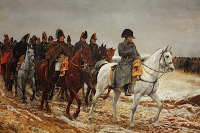 The wars started again, and Napoleon decidedthat if he could not live in peace with the rest of Europe, he would conquerit. He was brilliant. He smashed Austria at Austerlitz. He forcedPrussia to sue for peace. He first allied himself with Spain, and then took itover. He conquered Poland (or liberated it, depending on your point of view).Russia seemed powerless to stop him.The only nation Napoleon couldnot defeat was Great Britain. The British continued to defy him, and for a verygood reason—trade.
The wars started again, and Napoleon decidedthat if he could not live in peace with the rest of Europe, he would conquerit. He was brilliant. He smashed Austria at Austerlitz. He forcedPrussia to sue for peace. He first allied himself with Spain, and then took itover. He conquered Poland (or liberated it, depending on your point of view).Russia seemed powerless to stop him.The only nation Napoleon couldnot defeat was Great Britain. The British continued to defy him, and for a verygood reason—trade.
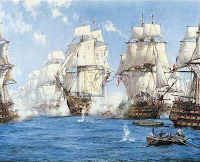 The most valuable trade was overseas, andBritain was master of the oceans. It had colonies across the globe and thegreatest navy in the world. For Napoleon to truly control Europe, the RoyalNavy had to be crushed, yet France failed time and time again. Every time theFrench attacked the British fleet in force, it was beaten and humiliated. Napoleon was invincible on land, but not atsea.Therefore, he tied tostrangle Britain. Napoleon's Continental System restricted trade. He hoped toeither force the "greedy English" to sue for peace, least they suffer ruin, orstarve the English populace into submission. However, he misjudged the natureof Englishmen. True, Napoleon had his admirers in Britain, particularly in theWhig camp of what passed for party politics of the day. But when it came to thesurvival of the British Isles the governments of George III and that of hisson, the Regent, were resolute. They knew that for Britain to live, Napoleonhad to be destroyed.
The most valuable trade was overseas, andBritain was master of the oceans. It had colonies across the globe and thegreatest navy in the world. For Napoleon to truly control Europe, the RoyalNavy had to be crushed, yet France failed time and time again. Every time theFrench attacked the British fleet in force, it was beaten and humiliated. Napoleon was invincible on land, but not atsea.Therefore, he tied tostrangle Britain. Napoleon's Continental System restricted trade. He hoped toeither force the "greedy English" to sue for peace, least they suffer ruin, orstarve the English populace into submission. However, he misjudged the natureof Englishmen. True, Napoleon had his admirers in Britain, particularly in theWhig camp of what passed for party politics of the day. But when it came to thesurvival of the British Isles the governments of George III and that of hisson, the Regent, were resolute. They knew that for Britain to live, Napoleonhad to be destroyed.
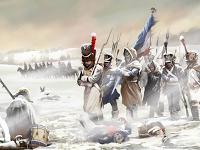 Stymied at sea, Napoleon grew overconfident onland. In 1812, he invaded Russia, and it was his greatest disaster—500,000 menmarched into Russia in June, but only 20,000 staggered back across the Niemenin December. This was the turning point in Napoleon's career. While he wonseveral desperate battles in 1813 and 1814, the luster of invincibility wasgone; his enemies knew he could be beaten. Unlike the past, his foes wouldn'ttreat with him—they stayed in the field to fight another day. French lossesmounted.
Stymied at sea, Napoleon grew overconfident onland. In 1812, he invaded Russia, and it was his greatest disaster—500,000 menmarched into Russia in June, but only 20,000 staggered back across the Niemenin December. This was the turning point in Napoleon's career. While he wonseveral desperate battles in 1813 and 1814, the luster of invincibility wasgone; his enemies knew he could be beaten. Unlike the past, his foes wouldn'ttreat with him—they stayed in the field to fight another day. French lossesmounted.
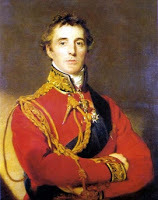 Meanwhile, theBritish found their own heroic figure—GeneralSir Arthur Wellesley. His brilliant campaigns in the Peninsula (Portugaland Spain) earned him fame and reward, and he was made 1st Duke of Wellington.In 1814, Napoleon was forcedto abdicate. The Allies forced him into exile on the Mediterranean island ofElba, established Louis XVIII as King of France, and began to redraw theshattered map of Europe at the Congressof Vienna.The peace did not last—onMarch 1, 1815, Napoleon landed near Frejus in Southern France. In less than amonth, he had returned to Paris and, the Bourbon king having fled, declaredhimself emperor again. The Allies formed the Seventh Coalition to stop him onceand for all. The British, Dutch, and Prussians would hold the north—in Belgium—whilethe Austrians and Russians mobilized to strike from the east. This was the Hundred Days Crisis.This could not have happed ata worse time for Britain. They had lost a great number of men in the Peninsula,and the rest of their best troops were still on the other side of the Atlantic,for the War of 1812 with America hadjust ended. Those men could not return in time, and Wellington, commander ofall British forces on the continent, had to build of army of reservists andgreen troops—his "Infamous Army."Napoleon knew he had tostrike fast—the decades of war had nearly emptied France of men. He could notfight the entire Coalition at once. Always he had divided and conquered, and heplanned to do it again. In his estimation, the troops to the north were themost vulnerable. He had beaten the Prussians before and was confident he wouldrout them again. As for Wellington, he dismissed the British field marshal as abad general with bad troops. He would crush them, expecting his victory wouldthen so frighten the other allies that they would sue for peace. This wouldgive him time to rebuild the French Army. Then, nothing would stop him.What happened next? That's in THE THREE COLONELS!The impact of the Battle ofWaterloo cannot be overestimated. Great Britain emerged from the wars as thepremiere imperial power on the planet. PaxBritannica would dominate the world for a hundred years. France wasrelegated to second-class stasis (whether they liked it or not). 1815 was alsothe last time Britain and France would fight each other. Beginning with the CrimeanWar in 1853, the two nations have been allies.Waterloo is one of those pivotalmoments in time. By happy coincidence, Jane Austen gave us interestingcharacters to borrow, through whom we can glimpse history in the making. I hopeI did her justice.THE THREE COLONELS – Jane Austen's Fighting Men is available nowfrom your favorite bookseller.
Meanwhile, theBritish found their own heroic figure—GeneralSir Arthur Wellesley. His brilliant campaigns in the Peninsula (Portugaland Spain) earned him fame and reward, and he was made 1st Duke of Wellington.In 1814, Napoleon was forcedto abdicate. The Allies forced him into exile on the Mediterranean island ofElba, established Louis XVIII as King of France, and began to redraw theshattered map of Europe at the Congressof Vienna.The peace did not last—onMarch 1, 1815, Napoleon landed near Frejus in Southern France. In less than amonth, he had returned to Paris and, the Bourbon king having fled, declaredhimself emperor again. The Allies formed the Seventh Coalition to stop him onceand for all. The British, Dutch, and Prussians would hold the north—in Belgium—whilethe Austrians and Russians mobilized to strike from the east. This was the Hundred Days Crisis.This could not have happed ata worse time for Britain. They had lost a great number of men in the Peninsula,and the rest of their best troops were still on the other side of the Atlantic,for the War of 1812 with America hadjust ended. Those men could not return in time, and Wellington, commander ofall British forces on the continent, had to build of army of reservists andgreen troops—his "Infamous Army."Napoleon knew he had tostrike fast—the decades of war had nearly emptied France of men. He could notfight the entire Coalition at once. Always he had divided and conquered, and heplanned to do it again. In his estimation, the troops to the north were themost vulnerable. He had beaten the Prussians before and was confident he wouldrout them again. As for Wellington, he dismissed the British field marshal as abad general with bad troops. He would crush them, expecting his victory wouldthen so frighten the other allies that they would sue for peace. This wouldgive him time to rebuild the French Army. Then, nothing would stop him.What happened next? That's in THE THREE COLONELS!The impact of the Battle ofWaterloo cannot be overestimated. Great Britain emerged from the wars as thepremiere imperial power on the planet. PaxBritannica would dominate the world for a hundred years. France wasrelegated to second-class stasis (whether they liked it or not). 1815 was alsothe last time Britain and France would fight each other. Beginning with the CrimeanWar in 1853, the two nations have been allies.Waterloo is one of those pivotalmoments in time. By happy coincidence, Jane Austen gave us interestingcharacters to borrow, through whom we can glimpse history in the making. I hopeI did her justice.THE THREE COLONELS – Jane Austen's Fighting Men is available nowfrom your favorite bookseller.
 About theAuthor
- JackCaldwell is an author, amateur historian, professional economic developer,playwright, and like many Cajuns, a darn good cook. Born and raised in theBayou County of Louisiana, Jack and his wife, Barbara, are Hurricane Katrinavictims who now make the upper Midwest their home.His nickname—The Cajun Cheesehead—came from his devotion to histwo favorite NFL teams: the New Orleans Saints and the Green Bay Packers. (Everynow and then, Jack has to play the DVD again to make sure the Saints really wonin 2010.)
About theAuthor
- JackCaldwell is an author, amateur historian, professional economic developer,playwright, and like many Cajuns, a darn good cook. Born and raised in theBayou County of Louisiana, Jack and his wife, Barbara, are Hurricane Katrinavictims who now make the upper Midwest their home.His nickname—The Cajun Cheesehead—came from his devotion to histwo favorite NFL teams: the New Orleans Saints and the Green Bay Packers. (Everynow and then, Jack has to play the DVD again to make sure the Saints really wonin 2010.)
 Always a history buff, Jack found and fell inlove with Jane Austen in his twenties, struck by her innate understanding ofthe human condition. Jack uses his work to share his knowledge of history.Through his characters, he hopes the reader gains a better understanding ofwhat went on before, developing an appreciation for our ancestors' trials andtribulations.When not writing or traveling with Barbara, Jack attempts to play golf.A devout convert to Roman Catholicism, Jack is married with three grown sons.Jack's blog postings—The Cajun Cheesehead Chronicles—appearregularly at Austen Authors.Web site –Ramblings of a Cajun in Exile –
http://webpages.charter.net/jvcla25/
Blog –Austen Authors –
http://austenauthors.net/
Facebook –
https://www.facebook.com/pages/Jack-Caldwell-author
Always a history buff, Jack found and fell inlove with Jane Austen in his twenties, struck by her innate understanding ofthe human condition. Jack uses his work to share his knowledge of history.Through his characters, he hopes the reader gains a better understanding ofwhat went on before, developing an appreciation for our ancestors' trials andtribulations.When not writing or traveling with Barbara, Jack attempts to play golf.A devout convert to Roman Catholicism, Jack is married with three grown sons.Jack's blog postings—The Cajun Cheesehead Chronicles—appearregularly at Austen Authors.Web site –Ramblings of a Cajun in Exile –
http://webpages.charter.net/jvcla25/
Blog –Austen Authors –
http://austenauthors.net/
Facebook –
https://www.facebook.com/pages/Jack-Caldwell-author

 Greetings, fellowhistory lovers! Jack Caldwell here, author of THE THREE COLONELS – JaneAusten's Fighting Men, the epic, romantic sequel to Pride & Prejudice and Sense & Sensibility, fromSourcebooks Landmark.I take the critical event ofthe Regency period in English history—theHundred Days Crisis—and throw some of literature's most beloved charactersinto that maelstrom. In other words, I send some of Austen's military figuresto Waterloo. From S&S are Marianneand Colonel Brandon, Elinor and Edward Ferrars, and John Willoughby. FromP&P are Colonel Fitzwilliam, Anne deBourgh, Lady Catherine, Fitzwilliam and Elizabeth Darcy, the Collinses,Wickham, Denny, and Caroline Bingley. I have original characters, like Colonel Sir John Buford, and theyinteract with historical figures, such as Wellingtonand Napoleon.
Greetings, fellowhistory lovers! Jack Caldwell here, author of THE THREE COLONELS – JaneAusten's Fighting Men, the epic, romantic sequel to Pride & Prejudice and Sense & Sensibility, fromSourcebooks Landmark.I take the critical event ofthe Regency period in English history—theHundred Days Crisis—and throw some of literature's most beloved charactersinto that maelstrom. In other words, I send some of Austen's military figuresto Waterloo. From S&S are Marianneand Colonel Brandon, Elinor and Edward Ferrars, and John Willoughby. FromP&P are Colonel Fitzwilliam, Anne deBourgh, Lady Catherine, Fitzwilliam and Elizabeth Darcy, the Collinses,Wickham, Denny, and Caroline Bingley. I have original characters, like Colonel Sir John Buford, and theyinteract with historical figures, such as Wellingtonand Napoleon.
 Please allow me a briefexplanation as to why Waterloo was so critical a moment in history. Since 1792,most of Europe had been at war against the armies of the French Revolution. Thehomicidal fanatics of the Revolution wanted to spread the ideas of liberté, égalité, fraternité—and "Madame Guillotine"—across thecontinent and England. The crowned heads of Europe and the Parliamentarykingdom of Great Britain felt the threat and tried to extinguish RevolutionaryFrance. Enthused with zeal, the French armies fought well against the might ofvarious Coalitions and was able to expand France into the Low Countries whileholding off for a time the forces organized against it.
Please allow me a briefexplanation as to why Waterloo was so critical a moment in history. Since 1792,most of Europe had been at war against the armies of the French Revolution. Thehomicidal fanatics of the Revolution wanted to spread the ideas of liberté, égalité, fraternité—and "Madame Guillotine"—across thecontinent and England. The crowned heads of Europe and the Parliamentarykingdom of Great Britain felt the threat and tried to extinguish RevolutionaryFrance. Enthused with zeal, the French armies fought well against the might ofvarious Coalitions and was able to expand France into the Low Countries whileholding off for a time the forces organized against it.
 The Republic couldn'thold—bad generalship externally and political instability internally broughtthe nation to the abyss. Then a heroic figure emerged—General Napoleon Bonaparte, a Corsican-turned-Frenchman, saved theFrench Army. He, with others, then conducted a coup in 1799, establishing agovernment run by three consuls, and Bonaparte became First Consul. Thebrilliant and ruthless general ended the revolutionary wars and, within a fewyears, maneuvered to rid himself of his fellow consuls. In 1804, he crownedhimself Emperor of France.General Bonaparte had wonadmiration for his reforms in France and respect for his abilities on thebattlefield, However, Emperor Napoleon Iwas something else entirely. Bonaparte was not of any royal house; he was acommoner. The crowned heads of Europe shook again. A commoner dared makehimself a king? Preposterous! Why, something like that might give ambitious menall over the continent ideas!
The Republic couldn'thold—bad generalship externally and political instability internally broughtthe nation to the abyss. Then a heroic figure emerged—General Napoleon Bonaparte, a Corsican-turned-Frenchman, saved theFrench Army. He, with others, then conducted a coup in 1799, establishing agovernment run by three consuls, and Bonaparte became First Consul. Thebrilliant and ruthless general ended the revolutionary wars and, within a fewyears, maneuvered to rid himself of his fellow consuls. In 1804, he crownedhimself Emperor of France.General Bonaparte had wonadmiration for his reforms in France and respect for his abilities on thebattlefield, However, Emperor Napoleon Iwas something else entirely. Bonaparte was not of any royal house; he was acommoner. The crowned heads of Europe shook again. A commoner dared makehimself a king? Preposterous! Why, something like that might give ambitious menall over the continent ideas!
 The wars started again, and Napoleon decidedthat if he could not live in peace with the rest of Europe, he would conquerit. He was brilliant. He smashed Austria at Austerlitz. He forcedPrussia to sue for peace. He first allied himself with Spain, and then took itover. He conquered Poland (or liberated it, depending on your point of view).Russia seemed powerless to stop him.The only nation Napoleon couldnot defeat was Great Britain. The British continued to defy him, and for a verygood reason—trade.
The wars started again, and Napoleon decidedthat if he could not live in peace with the rest of Europe, he would conquerit. He was brilliant. He smashed Austria at Austerlitz. He forcedPrussia to sue for peace. He first allied himself with Spain, and then took itover. He conquered Poland (or liberated it, depending on your point of view).Russia seemed powerless to stop him.The only nation Napoleon couldnot defeat was Great Britain. The British continued to defy him, and for a verygood reason—trade.
 The most valuable trade was overseas, andBritain was master of the oceans. It had colonies across the globe and thegreatest navy in the world. For Napoleon to truly control Europe, the RoyalNavy had to be crushed, yet France failed time and time again. Every time theFrench attacked the British fleet in force, it was beaten and humiliated. Napoleon was invincible on land, but not atsea.Therefore, he tied tostrangle Britain. Napoleon's Continental System restricted trade. He hoped toeither force the "greedy English" to sue for peace, least they suffer ruin, orstarve the English populace into submission. However, he misjudged the natureof Englishmen. True, Napoleon had his admirers in Britain, particularly in theWhig camp of what passed for party politics of the day. But when it came to thesurvival of the British Isles the governments of George III and that of hisson, the Regent, were resolute. They knew that for Britain to live, Napoleonhad to be destroyed.
The most valuable trade was overseas, andBritain was master of the oceans. It had colonies across the globe and thegreatest navy in the world. For Napoleon to truly control Europe, the RoyalNavy had to be crushed, yet France failed time and time again. Every time theFrench attacked the British fleet in force, it was beaten and humiliated. Napoleon was invincible on land, but not atsea.Therefore, he tied tostrangle Britain. Napoleon's Continental System restricted trade. He hoped toeither force the "greedy English" to sue for peace, least they suffer ruin, orstarve the English populace into submission. However, he misjudged the natureof Englishmen. True, Napoleon had his admirers in Britain, particularly in theWhig camp of what passed for party politics of the day. But when it came to thesurvival of the British Isles the governments of George III and that of hisson, the Regent, were resolute. They knew that for Britain to live, Napoleonhad to be destroyed.
 Stymied at sea, Napoleon grew overconfident onland. In 1812, he invaded Russia, and it was his greatest disaster—500,000 menmarched into Russia in June, but only 20,000 staggered back across the Niemenin December. This was the turning point in Napoleon's career. While he wonseveral desperate battles in 1813 and 1814, the luster of invincibility wasgone; his enemies knew he could be beaten. Unlike the past, his foes wouldn'ttreat with him—they stayed in the field to fight another day. French lossesmounted.
Stymied at sea, Napoleon grew overconfident onland. In 1812, he invaded Russia, and it was his greatest disaster—500,000 menmarched into Russia in June, but only 20,000 staggered back across the Niemenin December. This was the turning point in Napoleon's career. While he wonseveral desperate battles in 1813 and 1814, the luster of invincibility wasgone; his enemies knew he could be beaten. Unlike the past, his foes wouldn'ttreat with him—they stayed in the field to fight another day. French lossesmounted.
 Meanwhile, theBritish found their own heroic figure—GeneralSir Arthur Wellesley. His brilliant campaigns in the Peninsula (Portugaland Spain) earned him fame and reward, and he was made 1st Duke of Wellington.In 1814, Napoleon was forcedto abdicate. The Allies forced him into exile on the Mediterranean island ofElba, established Louis XVIII as King of France, and began to redraw theshattered map of Europe at the Congressof Vienna.The peace did not last—onMarch 1, 1815, Napoleon landed near Frejus in Southern France. In less than amonth, he had returned to Paris and, the Bourbon king having fled, declaredhimself emperor again. The Allies formed the Seventh Coalition to stop him onceand for all. The British, Dutch, and Prussians would hold the north—in Belgium—whilethe Austrians and Russians mobilized to strike from the east. This was the Hundred Days Crisis.This could not have happed ata worse time for Britain. They had lost a great number of men in the Peninsula,and the rest of their best troops were still on the other side of the Atlantic,for the War of 1812 with America hadjust ended. Those men could not return in time, and Wellington, commander ofall British forces on the continent, had to build of army of reservists andgreen troops—his "Infamous Army."Napoleon knew he had tostrike fast—the decades of war had nearly emptied France of men. He could notfight the entire Coalition at once. Always he had divided and conquered, and heplanned to do it again. In his estimation, the troops to the north were themost vulnerable. He had beaten the Prussians before and was confident he wouldrout them again. As for Wellington, he dismissed the British field marshal as abad general with bad troops. He would crush them, expecting his victory wouldthen so frighten the other allies that they would sue for peace. This wouldgive him time to rebuild the French Army. Then, nothing would stop him.What happened next? That's in THE THREE COLONELS!The impact of the Battle ofWaterloo cannot be overestimated. Great Britain emerged from the wars as thepremiere imperial power on the planet. PaxBritannica would dominate the world for a hundred years. France wasrelegated to second-class stasis (whether they liked it or not). 1815 was alsothe last time Britain and France would fight each other. Beginning with the CrimeanWar in 1853, the two nations have been allies.Waterloo is one of those pivotalmoments in time. By happy coincidence, Jane Austen gave us interestingcharacters to borrow, through whom we can glimpse history in the making. I hopeI did her justice.THE THREE COLONELS – Jane Austen's Fighting Men is available nowfrom your favorite bookseller.
Meanwhile, theBritish found their own heroic figure—GeneralSir Arthur Wellesley. His brilliant campaigns in the Peninsula (Portugaland Spain) earned him fame and reward, and he was made 1st Duke of Wellington.In 1814, Napoleon was forcedto abdicate. The Allies forced him into exile on the Mediterranean island ofElba, established Louis XVIII as King of France, and began to redraw theshattered map of Europe at the Congressof Vienna.The peace did not last—onMarch 1, 1815, Napoleon landed near Frejus in Southern France. In less than amonth, he had returned to Paris and, the Bourbon king having fled, declaredhimself emperor again. The Allies formed the Seventh Coalition to stop him onceand for all. The British, Dutch, and Prussians would hold the north—in Belgium—whilethe Austrians and Russians mobilized to strike from the east. This was the Hundred Days Crisis.This could not have happed ata worse time for Britain. They had lost a great number of men in the Peninsula,and the rest of their best troops were still on the other side of the Atlantic,for the War of 1812 with America hadjust ended. Those men could not return in time, and Wellington, commander ofall British forces on the continent, had to build of army of reservists andgreen troops—his "Infamous Army."Napoleon knew he had tostrike fast—the decades of war had nearly emptied France of men. He could notfight the entire Coalition at once. Always he had divided and conquered, and heplanned to do it again. In his estimation, the troops to the north were themost vulnerable. He had beaten the Prussians before and was confident he wouldrout them again. As for Wellington, he dismissed the British field marshal as abad general with bad troops. He would crush them, expecting his victory wouldthen so frighten the other allies that they would sue for peace. This wouldgive him time to rebuild the French Army. Then, nothing would stop him.What happened next? That's in THE THREE COLONELS!The impact of the Battle ofWaterloo cannot be overestimated. Great Britain emerged from the wars as thepremiere imperial power on the planet. PaxBritannica would dominate the world for a hundred years. France wasrelegated to second-class stasis (whether they liked it or not). 1815 was alsothe last time Britain and France would fight each other. Beginning with the CrimeanWar in 1853, the two nations have been allies.Waterloo is one of those pivotalmoments in time. By happy coincidence, Jane Austen gave us interestingcharacters to borrow, through whom we can glimpse history in the making. I hopeI did her justice.THE THREE COLONELS – Jane Austen's Fighting Men is available nowfrom your favorite bookseller.
 About theAuthor
- JackCaldwell is an author, amateur historian, professional economic developer,playwright, and like many Cajuns, a darn good cook. Born and raised in theBayou County of Louisiana, Jack and his wife, Barbara, are Hurricane Katrinavictims who now make the upper Midwest their home.His nickname—The Cajun Cheesehead—came from his devotion to histwo favorite NFL teams: the New Orleans Saints and the Green Bay Packers. (Everynow and then, Jack has to play the DVD again to make sure the Saints really wonin 2010.)
About theAuthor
- JackCaldwell is an author, amateur historian, professional economic developer,playwright, and like many Cajuns, a darn good cook. Born and raised in theBayou County of Louisiana, Jack and his wife, Barbara, are Hurricane Katrinavictims who now make the upper Midwest their home.His nickname—The Cajun Cheesehead—came from his devotion to histwo favorite NFL teams: the New Orleans Saints and the Green Bay Packers. (Everynow and then, Jack has to play the DVD again to make sure the Saints really wonin 2010.)
 Always a history buff, Jack found and fell inlove with Jane Austen in his twenties, struck by her innate understanding ofthe human condition. Jack uses his work to share his knowledge of history.Through his characters, he hopes the reader gains a better understanding ofwhat went on before, developing an appreciation for our ancestors' trials andtribulations.When not writing or traveling with Barbara, Jack attempts to play golf.A devout convert to Roman Catholicism, Jack is married with three grown sons.Jack's blog postings—The Cajun Cheesehead Chronicles—appearregularly at Austen Authors.Web site –Ramblings of a Cajun in Exile –
http://webpages.charter.net/jvcla25/
Blog –Austen Authors –
http://austenauthors.net/
Facebook –
https://www.facebook.com/pages/Jack-Caldwell-author
Always a history buff, Jack found and fell inlove with Jane Austen in his twenties, struck by her innate understanding ofthe human condition. Jack uses his work to share his knowledge of history.Through his characters, he hopes the reader gains a better understanding ofwhat went on before, developing an appreciation for our ancestors' trials andtribulations.When not writing or traveling with Barbara, Jack attempts to play golf.A devout convert to Roman Catholicism, Jack is married with three grown sons.Jack's blog postings—The Cajun Cheesehead Chronicles—appearregularly at Austen Authors.Web site –Ramblings of a Cajun in Exile –
http://webpages.charter.net/jvcla25/
Blog –Austen Authors –
http://austenauthors.net/
Facebook –
https://www.facebook.com/pages/Jack-Caldwell-author
Published on April 03, 2012 05:03
April 2, 2012
Independent Book Blogger Awards
I've entered History Undressed into the Independent Book Blogger Awards! Voting starts next week, so be sure to show H.U. some love!!!
/*<![CDATA[*/ #grBlogAwardWidget-box { padding: 15px; -webkit-box-shadow: 1px 1px 4px 1px #ccc; -moz-box-shadow: 1px 1px 4px 1px #ccc; box-shadow: 1px 1px 4px 1px #ccc; width: 265px } #grBlogAwardWidget-box img { float: left; } #grBlogAwardWidget-text { float: left; margin-left: 12px; width: 153px; } #grBlogAwardWidget-text p { font-family: Georgia, serif; font-size: 14px; margin: 0 0 8px 0; padding: 0; } #grBlogAwardWidget-text a { text-decoration: none; display: inline; display: inline-block; zoom:1; /* ie */ *display:inline; /* ie */ color: #222; font-weight: bold; padding: 0px 16px; line-height: 2; border: 1px solid #907164; -moz-border-radius: 5px; border-radius: 5px; -moz-box-shadow: #ddd 0px 3px 3px; box-shadow: #ddd 0px 3px 3px; font-family:arial,verdana,helvetica,sans-serif; font-size: 15px; font-weight: bold; text-align: center; background-color: #F5F5EA; background: linear-gradient(top, #F5F5EA, #D4CEB9); background: -ms-linear-gradient(top, #F5F5EA, #D4CEB9); background: -moz-linear-gradient(top, #F5F5EA, #D4CEB9); background: -o-linear-gradient(top, #F5F5EA, #D4CEB9); background: -webkit-linear-gradient(top, #F5F5EA, #D4CEB9); outline: 0; white-space: nowrap; } #grBlogAwardWidget-text a:hover { color: black; cursor: pointer; background-color: #E5DEC8; background: linear-gradient(top, #F9F9F0, #E5DEC8); background: -ms-linear-gradient(top, #F9F9F0, #E5DEC8); background: -moz-linear-gradient(top, #F9F9F0, #E5DEC8); background: -o-linear-gradient(top, #F9F9F0, #E5DEC8); background: -webkit-linear-gradient(top, #F9F9F0, #E5DEC8); } /*]]>*/

Vote for this blog for the Independent Book Blogger Awards!
Vote

/*<![CDATA[*/ #grBlogAwardWidget-box { padding: 15px; -webkit-box-shadow: 1px 1px 4px 1px #ccc; -moz-box-shadow: 1px 1px 4px 1px #ccc; box-shadow: 1px 1px 4px 1px #ccc; width: 265px } #grBlogAwardWidget-box img { float: left; } #grBlogAwardWidget-text { float: left; margin-left: 12px; width: 153px; } #grBlogAwardWidget-text p { font-family: Georgia, serif; font-size: 14px; margin: 0 0 8px 0; padding: 0; } #grBlogAwardWidget-text a { text-decoration: none; display: inline; display: inline-block; zoom:1; /* ie */ *display:inline; /* ie */ color: #222; font-weight: bold; padding: 0px 16px; line-height: 2; border: 1px solid #907164; -moz-border-radius: 5px; border-radius: 5px; -moz-box-shadow: #ddd 0px 3px 3px; box-shadow: #ddd 0px 3px 3px; font-family:arial,verdana,helvetica,sans-serif; font-size: 15px; font-weight: bold; text-align: center; background-color: #F5F5EA; background: linear-gradient(top, #F5F5EA, #D4CEB9); background: -ms-linear-gradient(top, #F5F5EA, #D4CEB9); background: -moz-linear-gradient(top, #F5F5EA, #D4CEB9); background: -o-linear-gradient(top, #F5F5EA, #D4CEB9); background: -webkit-linear-gradient(top, #F5F5EA, #D4CEB9); outline: 0; white-space: nowrap; } #grBlogAwardWidget-text a:hover { color: black; cursor: pointer; background-color: #E5DEC8; background: linear-gradient(top, #F9F9F0, #E5DEC8); background: -ms-linear-gradient(top, #F9F9F0, #E5DEC8); background: -moz-linear-gradient(top, #F9F9F0, #E5DEC8); background: -o-linear-gradient(top, #F9F9F0, #E5DEC8); background: -webkit-linear-gradient(top, #F9F9F0, #E5DEC8); } /*]]>*/

Vote for this blog for the Independent Book Blogger Awards!
Vote
Published on April 02, 2012 05:58
Weekly Video: History of the Holidays: Easter
Easter is coming up this weekend on Sunday, April 8th. In recognition, this week's video is from the History Channel, History of the Holidays: Easter.
Enjoy and Happy Easter!

Enjoy and Happy Easter!
Published on April 02, 2012 03:00
March 30, 2012
Goliad -- The Other Alamo by Celia Hayes
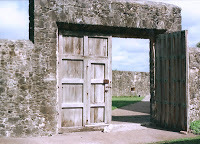 Welcome to History Undressed, guest author Celia Hayes! She's written a fascinating piece for us today on the America frontier. Enjoy!
Welcome to History Undressed, guest author Celia Hayes! She's written a fascinating piece for us today on the America frontier. Enjoy!
Goliad – The Other Alamo by Celia Hayes
At the very beginning, the 1835 revolt of Texian settlersagainst the authority of Mexico rather resembled the American Revolution, somesixty years before – a likeness not lost on the Anglo-American Texians. Boththe Colonies and the Texians were far-distant communities accustomed to managetheir own affairs with a bare minimum of interference from a central governingauthority. Colonists and Texians began standing on their rights as citizens,but a heavy-handed response provoked a response that spiraled into open revolt."Since they're trying to squash us like bugs for being rebellious, we might asgive them a real rebellion and put up a fight," summed up the attitude, in 1776as well as 1835.
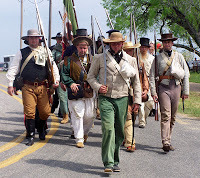 The Mexican government promptly sent an army to remind theAnglo-Texan settlers of who was really in charge. The rumor that among thebaggage carried along in General Martin Cos' was 800 pairs of iron hobbles,with which to march selected Texas rebels back to Mexico did win any friends among the Anglo or Hispanicsettlers in Texas, nor did the generals' widely reported remarks that it wastime to break up the foreign settlements in Texas. Cos' army, intended tore-establish and ensure Mexican authority, instead was ignominiously beaten andsent packing late in 1835.
The Mexican government promptly sent an army to remind theAnglo-Texan settlers of who was really in charge. The rumor that among thebaggage carried along in General Martin Cos' was 800 pairs of iron hobbles,with which to march selected Texas rebels back to Mexico did win any friends among the Anglo or Hispanicsettlers in Texas, nor did the generals' widely reported remarks that it wastime to break up the foreign settlements in Texas. Cos' army, intended tore-establish and ensure Mexican authority, instead was ignominiously beaten andsent packing late in 1835. 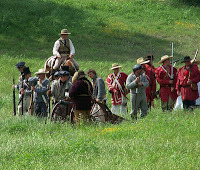
Over the winter of 1835-36 a scratch Texan army ofvolunteers held two presidios guarding the southern approaches from furtherinvasion, while representatives of the various communities met to sort out whatto do next. First, they formed a shaky provisional government, and appointedSam Houston to command the Army. Then, in scattershot fashion, they appointedthree more officers to high command; it would have been farcical, if theconsequences hadn't been so dire. With no clear command, with militarycompanies and commanders pursuing their own various plans and strategies, theTexas settlers and companies of volunteers were unprepared to face the terriblewrath of the Napoleon of the West and President of Mexico, strongman, caudilloand professional soldier, General Antonio Lopez de Santa Anna. He did not waitfor spring, or the grass to grow tall enough, or the deep mud to dry out: heintended to punish this rebellious province with the utmost severity. Under hispersonal command, his army reached the Rio Grande at Laredo in mid-February,and laid siege to a tumbledown former mission garrisoned by a scratch force ofvolunteers . . . San Antonio de Valero,called simply the Alamo. But this story is about the other presidio, and anothergarrison of Texans and volunteers; Bahia del Espiritu Santo, or Goliad.
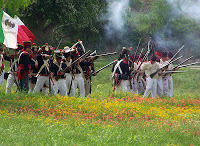 Santa Anna detached General Don Jose Urrea and a force ofabout a thousand soldiers, a third of them heavy cavalry, to guard his easternflank along the rivers and lowlands of the Gulf coast….and to mop up theAnglo-Texan garrisons at San Patricio and Goliad. A small force at SanPatricio, which had embarked on ill-considered expedition to raid Matamoros wassurrounded and wiped out. Then it was the turn of Colonel James Fannin with 500men holed up at the presidio in Goliad. Those 500 represented the largest bodyof fighting men among the Texians – and for the moment were still at large.Three couriers arrived from William Barrett Travis' tiny garrison in the Alamo,begging for help and reinforcements. Fannin was battered from each directionwith bad news and the consequences of bad decisions, or even worse, decisionsnot made until they were forced upon him. He made an abortive attempt to marchto San Antonio, to come to Travis' aid… butturned back after a few miles, assuming that relief of the Alamowas just not possible.
Santa Anna detached General Don Jose Urrea and a force ofabout a thousand soldiers, a third of them heavy cavalry, to guard his easternflank along the rivers and lowlands of the Gulf coast….and to mop up theAnglo-Texan garrisons at San Patricio and Goliad. A small force at SanPatricio, which had embarked on ill-considered expedition to raid Matamoros wassurrounded and wiped out. Then it was the turn of Colonel James Fannin with 500men holed up at the presidio in Goliad. Those 500 represented the largest bodyof fighting men among the Texians – and for the moment were still at large.Three couriers arrived from William Barrett Travis' tiny garrison in the Alamo,begging for help and reinforcements. Fannin was battered from each directionwith bad news and the consequences of bad decisions, or even worse, decisionsnot made until they were forced upon him. He made an abortive attempt to marchto San Antonio, to come to Travis' aid… butturned back after a few miles, assuming that relief of the Alamowas just not possible.
 In the mean time, spurred by the knowledge that they musteither fight, or go under, to death or exile, a new convention of settlers metat Washington-on-the-Brazos, and declared independence on March 2. In shorttime they had drafted a constitution, elected an interim government, andcommissioned Sam Houston as commander of what army was left. Houstonwent to Gonzalez, intending to rally the settlers' militia there and lift thesiege of the Alamo. He arrived there on thevery same day that news came that Santa Anna's army had finally broken throughthe walls. Travis' rag-tag collection of volunteers had held for fourteen days.They had bought time with their blood. Houston sent word to Fannin, orderinghim to retreat north. But Fannin had sent out a small force to protectAnglo-Texan settlers in a nearby town, and refused to leave until he heard fromthem. When he finally decided to fall back, and join up with Houston, it was already too late. Urrea'scolumn had already made contact. Fannin and his men moved out of Goliad onMarch 19th, temporarily shielded by fog, but they were caught in theopen, a little short of Coleto Creek. They fought in a classic hollow square,three ranks deep for a day and a night, tormented by lack of water, and thecries of the wounded. By daylight the next morning, Urrea had brought up fieldguns, and raked the square with grapeshot.
In the mean time, spurred by the knowledge that they musteither fight, or go under, to death or exile, a new convention of settlers metat Washington-on-the-Brazos, and declared independence on March 2. In shorttime they had drafted a constitution, elected an interim government, andcommissioned Sam Houston as commander of what army was left. Houstonwent to Gonzalez, intending to rally the settlers' militia there and lift thesiege of the Alamo. He arrived there on thevery same day that news came that Santa Anna's army had finally broken throughthe walls. Travis' rag-tag collection of volunteers had held for fourteen days.They had bought time with their blood. Houston sent word to Fannin, orderinghim to retreat north. But Fannin had sent out a small force to protectAnglo-Texan settlers in a nearby town, and refused to leave until he heard fromthem. When he finally decided to fall back, and join up with Houston, it was already too late. Urrea'scolumn had already made contact. Fannin and his men moved out of Goliad onMarch 19th, temporarily shielded by fog, but they were caught in theopen, a little short of Coleto Creek. They fought in a classic hollow square,three ranks deep for a day and a night, tormented by lack of water, and thecries of the wounded. By daylight the next morning, Urrea had brought up fieldguns, and raked the square with grapeshot. 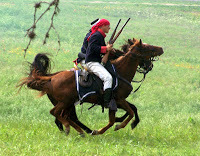 Fannin signaled for a parley and surrendered; he and his menbelieving they would be permitted honorable terms. They were brought back toGoliad and held under guard in the presidio for a week, along with some Texian stragglerswho had been rounded up in the neighborhood, and a party of volunteers newlyarrived from the States. They were locked up in the small presidio chapel atnight; under such tight conditions as they slept standing up, leaning againstthe stone walls or each other. Fanninand his men all assumed they would be disarmed, and sent back to the UnitedStates. Three English-speaking professional soldiers among Urreas' officers assumedthe same. They were horrified when Santa Anna sent orders that all theprisoners were to be executed. Urrea himself asked for leniency and ColonelPortillo, the commander left in charge of Goliad was personally revolted … buthe obeyed orders.
Fannin signaled for a parley and surrendered; he and his menbelieving they would be permitted honorable terms. They were brought back toGoliad and held under guard in the presidio for a week, along with some Texian stragglerswho had been rounded up in the neighborhood, and a party of volunteers newlyarrived from the States. They were locked up in the small presidio chapel atnight; under such tight conditions as they slept standing up, leaning againstthe stone walls or each other. Fanninand his men all assumed they would be disarmed, and sent back to the UnitedStates. Three English-speaking professional soldiers among Urreas' officers assumedthe same. They were horrified when Santa Anna sent orders that all theprisoners were to be executed. Urrea himself asked for leniency and ColonelPortillo, the commander left in charge of Goliad was personally revolted … buthe obeyed orders. On the morning of Palm Sunday, 1836, those of Fannin'sgarrison able to walk - about threehundred - were divided into threegroups, and marched out of town in three different directions, before beingshot down by their guards. Forty wounded were dragged into the courtyard infront of the chapel doors and executed as they lay on the ground. Fanninhimself was shot last of all, knowing what had happened to his men. Reportedlyhe asked only that he not be shot in the face, that his personal belongings besent to his family, and that he be given decent burial. He was executed atpoint blank range with a shot in the face, his belongings were looted and hisbody was dumped into a trench with those of others and burnt, although manywere left where they lay. A handful survived by escaping into the brush orjumping into the river. Another handful of prisoners were kept out of thecolumns; they were concealed in the Presidio by one of Portillo's officers orrescued by Francita Alavez, the common-law wife of Captain Telesforo Alavez,who would become known as the Angel of Goliad,
 Santa Anna, who had been thought of as a competent soldierand a more than usually slippery politician, was branded a brute - and as hewas decoyed farther and farther into Texas in pursuit of Sam Houston - anoverreaching and arrogant fool. A month later, when Houston and finished fallingback into East Texas and training all the men who had gathered to him, Houston'sarmy turned and fought. Santa Anna's grandarmy disintegrated, as Houston's men shouted "Remember the Alamo!"… and"Remember Goliad!"
Santa Anna, who had been thought of as a competent soldierand a more than usually slippery politician, was branded a brute - and as hewas decoyed farther and farther into Texas in pursuit of Sam Houston - anoverreaching and arrogant fool. A month later, when Houston and finished fallingback into East Texas and training all the men who had gathered to him, Houston'sarmy turned and fought. Santa Anna's grandarmy disintegrated, as Houston's men shouted "Remember the Alamo!"… and"Remember Goliad!"
 My own series about the Germans in Texas, the AdelsvereinTrilogy, starts with a boy soldier escaping from the massacre, which experienceaffects him for the rest of his life. It is a curiosity of history that theAlamo is famous, and the Goliad hardly known outside of Texas. Writer JohnWillingham, who came out with a novel about James Fannin and the Goliad lastyear, speculates that it might have been because the siege and fall of theAlamo tapped into a kind of 'heroic last stand of the 300 at Thermopylae'mind-set, while the massacre of the Texians at Goliad was a sad and squalidexercise in judicial murder.
My own series about the Germans in Texas, the AdelsvereinTrilogy, starts with a boy soldier escaping from the massacre, which experienceaffects him for the rest of his life. It is a curiosity of history that theAlamo is famous, and the Goliad hardly known outside of Texas. Writer JohnWillingham, who came out with a novel about James Fannin and the Goliad lastyear, speculates that it might have been because the siege and fall of theAlamo tapped into a kind of 'heroic last stand of the 300 at Thermopylae'mind-set, while the massacre of the Texians at Goliad was a sad and squalidexercise in judicial murder. ABOUT THE AUTHOR
ABOUT THE AUTHORCelia Hayes lives in San Antonio, Texas and is the author of six novels set on the American frontier: To Truckee's Trail -- an account of the first wagon train to cross the Sierra Nevada, the Adelsverein Trilogy -- which tells the story of the German settlements in the Texas Hill Country, and Daughter of Texas, and Deep in the Heart, a two-part account of a woman's life during the years of the Republic of Texas. Visit Celia at http://www.celiahayes.com
*Pictures were taken on scene by the author.
Published on March 30, 2012 06:48
March 28, 2012
Miss Kitty Lied by Jennifer Jakes
Welcome back to History Undressed, Jennifer Jakes! If you didn't view her previous post on historical vibrators, you've got to check it out! Today she's tantalizing us with a bit on historical prostitutes. Enjoy!
Miss Kitty Liedby Jennifer Jakes
 Oh, Miss Kitty, how you deceived us all. Remember Gunsmoke and Sheriff Matt Dillon's main squeeze? Perfect silk dress, perfectly styled red curls – perfect beauty mark. How clean and wonderful the life of a Wild West saloon girl must have been. . .
Oh, Miss Kitty, how you deceived us all. Remember Gunsmoke and Sheriff Matt Dillon's main squeeze? Perfect silk dress, perfectly styled red curls – perfect beauty mark. How clean and wonderful the life of a Wild West saloon girl must have been. . .
*insert sound of screeching brakes here*
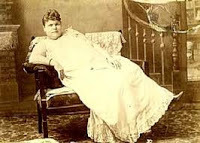 Um, no. Let's look at some facts. In descending order there were: Parlor Houses, Brothels, Cribs. Even in a Parlor House *think 5 star hotel* where a night of food, fun and the other "F" word might cost a man $200+, the girl only averaged $10 per week because of the cut the Madam (or the house) took the rest to cover the costs of food, wine and the girl's room and board.
Um, no. Let's look at some facts. In descending order there were: Parlor Houses, Brothels, Cribs. Even in a Parlor House *think 5 star hotel* where a night of food, fun and the other "F" word might cost a man $200+, the girl only averaged $10 per week because of the cut the Madam (or the house) took the rest to cover the costs of food, wine and the girl's room and board.
 Brothel girls could make $2.50 - $7.00 per customer, but she had to pay room and board out of this plus any other expenses she had. Oh, and Brothels were significantly less grand than a Parlor House. Parlor houses the girl probably spent the entire night with one man and her sheets were changed afterward. Brothel girls saw more "traffic" and her sheets might be changed once per week.
Brothel girls could make $2.50 - $7.00 per customer, but she had to pay room and board out of this plus any other expenses she had. Oh, and Brothels were significantly less grand than a Parlor House. Parlor houses the girl probably spent the entire night with one man and her sheets were changed afterward. Brothel girls saw more "traffic" and her sheets might be changed once per week.
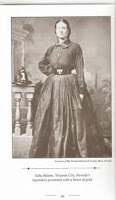 Cribs were a closet-like space where the girls lived and worked. She would rent this room for $10-$20 per week. She charged a man as little as 25 cents depending on how dirty or run-down she and/or her crib was. Her profit was in volume. In a cattle or mining town, she would little more than stay in bed as the men lined up outside her door. Normally, a crib nymph would see 20 to 30 men per night. During a cattle drive, she could see as many as 75 to 100 men per night. And no clean sheets here. She put a rain slicker over the bottom of her bed to protect the sheets from mud and cow manure since the cowboy might take off his hat, but not his boots or pants. Volume, remember?
Cribs were a closet-like space where the girls lived and worked. She would rent this room for $10-$20 per week. She charged a man as little as 25 cents depending on how dirty or run-down she and/or her crib was. Her profit was in volume. In a cattle or mining town, she would little more than stay in bed as the men lined up outside her door. Normally, a crib nymph would see 20 to 30 men per night. During a cattle drive, she could see as many as 75 to 100 men per night. And no clean sheets here. She put a rain slicker over the bottom of her bed to protect the sheets from mud and cow manure since the cowboy might take off his hat, but not his boots or pants. Volume, remember?
Yes, there were Saloon Girls who could just serve drinks, but they could also "go upstairs" for extra money. And Dance Hall Girls, yes, they were there, earning 12 ½ cents per dance. But all in all after researching this topic, I have to say, Miss Kitty lied to us.
What do you think?
*All statistics were found in UPSTAIRS GIRLS: Prostitution in the American West by Michael Rutter

Jennifer Jakes is the author of sensual erotic romance. Her award-winning debut novel, RAFE'S REDEMPTION, a historical western, is available now from The Wilder Rose Press, Amazon and other fine retailers. Her newest novella, TWICE IN A LIFETIME, is available at Amazon, B & N and Smashwords.
Find out more about Jennifer at www.jenniferjakes.com or at her blog http://authorjenniferjakes.blogspot.com/
RAFE'S REDEMPTION BUY LINK
Amazon Buy
 He rode into town to buy supplies, not a woman.
He rode into town to buy supplies, not a woman.
For hunted recluse Rafe McBride, the raven-haired beauty onthe auction block is exactly what he doesn't need. A dependent woman willbe another clue his vengeful stepbrother can use to find and kill him. ButRafe's conscience won't let him leave another innocent's virginity to theriff-raff bidding. He buys her, promising to return her to St. Louis untouched.He only prays the impending blizzard holds off before her sultry beauty breakshis willpower.
She wanted freedom, not a lover.
Whisked to the auction block by her devious, gamblingcousin, and then sold into the arms of a gorgeous stranger, outspoken artistMaggie Monroe isn't about to go meekly. Especially when the rugged mountain manlooks like sin and danger rolled into one. But a blizzard and temptation thrustthem together, and Maggie yearns to explore her smoldering passion for Rafe.
But when the snow clears, will the danger and secrets thatsurround Rafe and Maggie tear them apart?

Miss Kitty Liedby Jennifer Jakes
 Oh, Miss Kitty, how you deceived us all. Remember Gunsmoke and Sheriff Matt Dillon's main squeeze? Perfect silk dress, perfectly styled red curls – perfect beauty mark. How clean and wonderful the life of a Wild West saloon girl must have been. . .
Oh, Miss Kitty, how you deceived us all. Remember Gunsmoke and Sheriff Matt Dillon's main squeeze? Perfect silk dress, perfectly styled red curls – perfect beauty mark. How clean and wonderful the life of a Wild West saloon girl must have been. . .*insert sound of screeching brakes here*
 Um, no. Let's look at some facts. In descending order there were: Parlor Houses, Brothels, Cribs. Even in a Parlor House *think 5 star hotel* where a night of food, fun and the other "F" word might cost a man $200+, the girl only averaged $10 per week because of the cut the Madam (or the house) took the rest to cover the costs of food, wine and the girl's room and board.
Um, no. Let's look at some facts. In descending order there were: Parlor Houses, Brothels, Cribs. Even in a Parlor House *think 5 star hotel* where a night of food, fun and the other "F" word might cost a man $200+, the girl only averaged $10 per week because of the cut the Madam (or the house) took the rest to cover the costs of food, wine and the girl's room and board. Brothel girls could make $2.50 - $7.00 per customer, but she had to pay room and board out of this plus any other expenses she had. Oh, and Brothels were significantly less grand than a Parlor House. Parlor houses the girl probably spent the entire night with one man and her sheets were changed afterward. Brothel girls saw more "traffic" and her sheets might be changed once per week.
Brothel girls could make $2.50 - $7.00 per customer, but she had to pay room and board out of this plus any other expenses she had. Oh, and Brothels were significantly less grand than a Parlor House. Parlor houses the girl probably spent the entire night with one man and her sheets were changed afterward. Brothel girls saw more "traffic" and her sheets might be changed once per week. Cribs were a closet-like space where the girls lived and worked. She would rent this room for $10-$20 per week. She charged a man as little as 25 cents depending on how dirty or run-down she and/or her crib was. Her profit was in volume. In a cattle or mining town, she would little more than stay in bed as the men lined up outside her door. Normally, a crib nymph would see 20 to 30 men per night. During a cattle drive, she could see as many as 75 to 100 men per night. And no clean sheets here. She put a rain slicker over the bottom of her bed to protect the sheets from mud and cow manure since the cowboy might take off his hat, but not his boots or pants. Volume, remember?
Cribs were a closet-like space where the girls lived and worked. She would rent this room for $10-$20 per week. She charged a man as little as 25 cents depending on how dirty or run-down she and/or her crib was. Her profit was in volume. In a cattle or mining town, she would little more than stay in bed as the men lined up outside her door. Normally, a crib nymph would see 20 to 30 men per night. During a cattle drive, she could see as many as 75 to 100 men per night. And no clean sheets here. She put a rain slicker over the bottom of her bed to protect the sheets from mud and cow manure since the cowboy might take off his hat, but not his boots or pants. Volume, remember? Yes, there were Saloon Girls who could just serve drinks, but they could also "go upstairs" for extra money. And Dance Hall Girls, yes, they were there, earning 12 ½ cents per dance. But all in all after researching this topic, I have to say, Miss Kitty lied to us.
What do you think?
*All statistics were found in UPSTAIRS GIRLS: Prostitution in the American West by Michael Rutter

Jennifer Jakes is the author of sensual erotic romance. Her award-winning debut novel, RAFE'S REDEMPTION, a historical western, is available now from The Wilder Rose Press, Amazon and other fine retailers. Her newest novella, TWICE IN A LIFETIME, is available at Amazon, B & N and Smashwords.
Find out more about Jennifer at www.jenniferjakes.com or at her blog http://authorjenniferjakes.blogspot.com/
RAFE'S REDEMPTION BUY LINK
Amazon Buy
 He rode into town to buy supplies, not a woman.
He rode into town to buy supplies, not a woman.For hunted recluse Rafe McBride, the raven-haired beauty onthe auction block is exactly what he doesn't need. A dependent woman willbe another clue his vengeful stepbrother can use to find and kill him. ButRafe's conscience won't let him leave another innocent's virginity to theriff-raff bidding. He buys her, promising to return her to St. Louis untouched.He only prays the impending blizzard holds off before her sultry beauty breakshis willpower.
She wanted freedom, not a lover.
Whisked to the auction block by her devious, gamblingcousin, and then sold into the arms of a gorgeous stranger, outspoken artistMaggie Monroe isn't about to go meekly. Especially when the rugged mountain manlooks like sin and danger rolled into one. But a blizzard and temptation thrustthem together, and Maggie yearns to explore her smoldering passion for Rafe.
But when the snow clears, will the danger and secrets thatsurround Rafe and Maggie tear them apart?
Published on March 28, 2012 02:00
March 27, 2012
Historical Romance Review: Never Seduce a Scoundrel by Heather Grothaus
 Never Seduce a ScoundrelKensington ZebraISBN-13: 978-1420112436
Never Seduce a ScoundrelKensington ZebraISBN-13: 978-1420112436
ABOUT THE BOOK
Even a cloistered young heiress in medieval England has herreckless moments. . .
Lord Oliver Bellecote has a way of bringing out the vixen inany woman. Any woman, that is, but Cecily Foxe, an innocent flower destined forthe abbey who seems utterly immune to his charms. Or so he believes until thenight they accidentally meet in the pagan ruins of Foxe Ring, and Oliverdiscovers that "Saint Cecily" is actually as tempting as sin. . .
Cecily would like nothing more than to forget her night ofheated passion with the dangerously handsome Lord Bellecote. But denial provesquite impossible when she is charged with tending his every need during hisstay at Fallstowe Castle. For only in his arms does she feel truly alive,despite the deadly secrets that surround his past--and threaten their tenuousfuture. . .
MY REVIEW
I literally read this book in a day. Never Seduce a Scoundrel, is a medieval romance novel that takes place in England (haven't read one of those in a long time!), and it was jam-packed with action, conflict, sensuality. I've never read a book by Ms. Grothaus before, and I am now a fan! Can't wait for the next book in this series to release.
There was a subtle humor laced into the book that had me snickering as I read--such as Cecily's thoughts on people, people being people--ie being clumsy! It was fantastic how she brought these characters to life. They were "real" people, jumping right off the page and acting out the scenes before my eyes. They were also flawed. All of them had some sort of issue to overcome, and I enjoyed their journeys to a fulfilling end.
But most of all, I enjoyed the interaction between the characters and following the character's along their paths to finding out who they are. The novel is very character driven. There is a bit of a mystery to it as well. Poor Oliver and Cecily. I hate to say that I revel in novels that get the h/h together with a bang (lol) in the beginning and them they are forced apart, trying to understand their feelings for one another, and also figure themselves out before they can finally be together in the end. Its painful, but oh-so-wonderful when they finally reach the HEA.
As far as historical details, the author painted an accurate picture, and did so subtly, so I could mostly fill in the blanks with my own imagination.
A definite recommended read!
Published on March 27, 2012 07:00
Historical Fiction Review: The Queen's Gamble by Barbara Kyle
[image error]
ABOUT THE BOOKBook #4 in the Thornleigh Series
Kensington Trade Paperback ISBN-13: 978-0758238566
Young Queen Elizabeth I's path to the throne has been a perilous one, and already she faces a dangerous crisis. French troops have landed in Scotland to quell a rebel Protestant army, and Elizabeth fears once they are entrenched on the border, they will invade England.
Isabel Thornleigh has returned to London from the New World with her Spanish husband, Carlos Valverde, and their young son. Ever the queen's loyal servant, Isabel is recruited to smuggle money to the Scottish rebels. Yet Elizabeth's trust only goes so far—Isabel's son will be the queen's pampered hostage until she completes her mission. Matters grow worse when Isabel's husband is engaged as military advisor to the French, putting the couple on opposite sides in a deadly cold war.
MY REVIEW
Applause is due to Ms. Kyle. THE QUEEN'S GAMBLE, was a riveting, dramatic tale. A story filled with intrigue, drama, subtle sensuality and a daring, evocative heroine. I couldn't turn the pages fast enough.
I have long been a lover, and more than a little bit obsessed with the Tudor rulers. I felt that the author vividly captured the personality and bearing of one of England's most notorious female rulers, Elizabeth I.
There is so much going on within this story. So much conflict that I wasn't sure how it would turn out--even had my doubts about the ending. Our heroine's family is close to this current Queen. But her own husband is Spanish--a country the Queen is currently not on good terms with. To make matters worse, Isabel's and her husband have made their home in the new world.
And the Queen well knows what is at stake for Isabel as she takes on the dubious tasks set on her by Cecil and the Queen--and takes her son as collateral. Her son's life could be at stake. Even worse--her husband is now working on the opposite side of the fence so to speak.
Isabel is once gutsy woman, who is willing to go to the very edge for her family and what she believes in. This is definitely a recommended read. The love between Isabel and Carlos will have you melting, all while you chew your nails off to find out what happens in the end.

ABOUT THE BOOKBook #4 in the Thornleigh Series
Kensington Trade Paperback ISBN-13: 978-0758238566
Young Queen Elizabeth I's path to the throne has been a perilous one, and already she faces a dangerous crisis. French troops have landed in Scotland to quell a rebel Protestant army, and Elizabeth fears once they are entrenched on the border, they will invade England.
Isabel Thornleigh has returned to London from the New World with her Spanish husband, Carlos Valverde, and their young son. Ever the queen's loyal servant, Isabel is recruited to smuggle money to the Scottish rebels. Yet Elizabeth's trust only goes so far—Isabel's son will be the queen's pampered hostage until she completes her mission. Matters grow worse when Isabel's husband is engaged as military advisor to the French, putting the couple on opposite sides in a deadly cold war.
MY REVIEW
Applause is due to Ms. Kyle. THE QUEEN'S GAMBLE, was a riveting, dramatic tale. A story filled with intrigue, drama, subtle sensuality and a daring, evocative heroine. I couldn't turn the pages fast enough.
I have long been a lover, and more than a little bit obsessed with the Tudor rulers. I felt that the author vividly captured the personality and bearing of one of England's most notorious female rulers, Elizabeth I.
There is so much going on within this story. So much conflict that I wasn't sure how it would turn out--even had my doubts about the ending. Our heroine's family is close to this current Queen. But her own husband is Spanish--a country the Queen is currently not on good terms with. To make matters worse, Isabel's and her husband have made their home in the new world.
And the Queen well knows what is at stake for Isabel as she takes on the dubious tasks set on her by Cecil and the Queen--and takes her son as collateral. Her son's life could be at stake. Even worse--her husband is now working on the opposite side of the fence so to speak.
Isabel is once gutsy woman, who is willing to go to the very edge for her family and what she believes in. This is definitely a recommended read. The love between Isabel and Carlos will have you melting, all while you chew your nails off to find out what happens in the end.
Published on March 27, 2012 02:00
March 26, 2012
Solid as Stone by Kathleen Bittner-Roth
 I would like to welcome back to History Undressed, by dear friend, Kathleen Bittner-Roth! She has written yet another fascinating post for us. Enjo
y!
I would like to welcome back to History Undressed, by dear friend, Kathleen Bittner-Roth! She has written yet another fascinating post for us. Enjo
y!SOLID AS STONE by Kathleen Bittner-Roth
 Whether reading ahistorical romance or writing one, those resplendent stone manor houses (andcastles) serve not only as a backdrop for the players, but the stone buildings oftenbecome characters unto themselves. A mood can instantly be conjured by thedescription of a dwelling.
Whether reading ahistorical romance or writing one, those resplendent stone manor houses (andcastles) serve not only as a backdrop for the players, but the stone buildings oftenbecome characters unto themselves. A mood can instantly be conjured by thedescription of a dwelling. Imagine your woundedhero riding up the long, tree-lined drive to his boyhood home, returning afteryears in absentia. As the stark grey fortress looms ahead, its cold stone wallsfilled with dark secrets, his past rises up to haunt him.
 Or what of aheroine, contracted at birth to marry a brooding duke she detests. Sick withanguish, she arrives in the ducal carriage he's provided, only to spy a stonemanor house that, despite its grand size, bears warmth and invitation, itsstone walls a soft, welcoming honey tone flanked by beds of colorful springflowers. Who is this man to have created such a place, she wonders?
Or what of aheroine, contracted at birth to marry a brooding duke she detests. Sick withanguish, she arrives in the ducal carriage he's provided, only to spy a stonemanor house that, despite its grand size, bears warmth and invitation, itsstone walls a soft, welcoming honey tone flanked by beds of colorful springflowers. Who is this man to have created such a place, she wonders?The history of buildingwith stone in England is a story unto itself. The tradition goes back athousand years. When the Normans conquered Britain in 1066, they constructedcastles, monasteries and royal houses out of stone. Stone had not the fire riskof the old pier and beam buildings, and it could be carved to create artfulornamentation, the more intricate andextensive the carvings, the greater the standing. Soon, stone became a symbolof high status.
 The grandest ofstones was imported from France or carted across the countryside from quarriesestablished as the finest in England. The way the stone was laid and the quality ofthe work was just as important as the stone itself and was directly related tothe status of the owner.
The grandest ofstones was imported from France or carted across the countryside from quarriesestablished as the finest in England. The way the stone was laid and the quality ofthe work was just as important as the stone itself and was directly related tothe status of the owner.After a time, stonehomes became common as quarries sprang up in many towns and villages. A tourthrough a few stone quarries gave me a different slant when writing historicalromance. I learned that in the Costwolds, for instance, it's the rich, honeytones that prevail. I learned those gray stone manor houses were usuallyBarnack stone, dug from quarries in Northamptonshire. Yet another honey-tonedstone is the Chilmark, found in Wiltshire.
 Stone is stillfavored today in England, with Limestone, granite and sandstone being the threechief building stones. Did you know stone is found under about twenty-one feetof clay!
Stone is stillfavored today in England, with Limestone, granite and sandstone being the threechief building stones. Did you know stone is found under about twenty-one feetof clay!I doubt I couldwrite a story without including some kind of a dwelling that fleshes out mycharacters in one way or another. What about you? Do you find the homes yourheroes and heroines live play an integral part in the story you are writing or reading?I'd love to hear from you.
Published on March 26, 2012 06:22
March 23, 2012
Guest Author Diva Jefferson
 Today on History Undressed, I'd like to welcome a new guest author, Diva Jefferson. Diva writes Irish historical romance and has shared a bit of history behind her book, TO LOVE AN IRISHMAN. Enjoy!
Today on History Undressed, I'd like to welcome a new guest author, Diva Jefferson. Diva writes Irish historical romance and has shared a bit of history behind her book, TO LOVE AN IRISHMAN. Enjoy!
Imagine your life in a luscious, green worldfull of ancient stories, magic, and mystery. You have a unique language only toyour people, a diverse religion, and a divine unity with your neighbors. Thenyou realize the wonderful sphere around you is torn asunder. Soon Penal Lawsprevent you from practicing your religion, speaking your language, and owningyour own land. In the early 1800s (before the GreatFamine in the 1840s), Ireland was a place full of opportunity for only aprivileged few, and a large holder of oppression. English rulers dictated theircountrymen to move onto greener pastures, and gave them wide expanses of Irishland to do with what they will. This was called land tenure. Land was a sourceof income, a source of political power, and a great source of food, fuel,space, and sport. These landowners, or land agents, took over their designatedproperties, forcing the Irish people from their homes, sometimes paying them toemigrate. Those who had nowhere to go were carted to workhouses or worked inthe quarries. Workhouses or they were called 'Houses of Industry' before 1838,were disease-infested, prison-like places of work where people without means toprovide for themselves lived. Here, men broke stones and women knitted for lowwages. It was definitely not a great way spend a life. Those who managed to keep their landwere subject to very high taxes (and rents) based solely on their holdings. Theamount of that tax, or 'tithe', funded the Church of Ireland, the countygovernment, workhouses, dispensaries (medical facilities), Trinity College, andendowed schools. Many threats of eviction were held over the people's heads andlivestock were seized if rents were unpaid. Rents were usually collected twicea year, generally in hotels. Anyone who became evicted and indebted to theirland agents was publicly humiliated. This is a reason why so many Irish choseto become clergymen because they were excluded from this taxing.Others who escaped workhouses became farmers.Tenant farmers, paid taxes and lived on the land. They were sometimes referredto as 'managers'. Farm laborers were paid no more than eight pence a day and givensmall plots of land with which to feed their families. Family farms were the most populartype, and they were twenty-five acres or more. Most Irish farms grew potatoes,but cabbage, onions, wheat, barley, oats, and flax were also commonly grown aswell as raising livestock. A half-acre could feed a whole family for a year.All other produce and livestock would be sold at market places in large citiesor shipped to the Americas and the British Isles. Life on a farm is hard work done everyday. Learn more about farming equipment and techniques in my book To Love An Irishman.
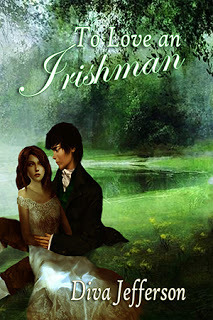 ABOUT THE BOOK:
ABOUT THE BOOK:She is left with anoffer she cannot refuse...
Upon his death in 1823, English nobleman, LordPeyton leaves his daughter Lady Aveline with two choices—stay single andinherit only a small farm in Ireland, where she might just be able to eke out aliving, or get married and live in luxury, inheriting all his wealth and property.Fiercely independent, Aveline heads for Ireland only to run afoul of herfather's farm manager, the devastatingly handsome Ciaran O''Devlin. Alone in astrange country, Aveline yearns for love and friendship, but Ciaran offers onlycriticism and disdain. Confused and angered by strange visions and her growingattraction to Ciaran, Aveline is determined to make the farm prosper—despite theinsufferable Irishman.
He has a secret he cannotreveal...
Ciaran mistrusts Aveline's intentions andrefuses to admit that a willful, Englishwoman now owns the farm that should have been his. Although he insists Avelineshould go back to England, he cannot deny their budding passion. Yet, he knows—evenif she doesn't—that nothing will come of it. Not only can't a poor Irishmanmarry an English noblewoman, but when Aveline learns of his past, she'll wantnothing more to do with him. Ciaran has always known that each decision carriesa consequence, but it's only when he stands to lose Aveline that he realizeswhat a heavy price his past decisions may have.
AN EXCERPT:
Aveline couldn't tear hereyes away. The man was gorgeous—and most unfriendly...
One of the men stood out from theothers. His clothing was obviously expensive, despite its poor condition.Aveline stood quietly and observed him through the crack of the door, wonderingwho he was.He discarded his brown swallowtail coatand threw it over the stall wall, leaving only a green cotton waistcoat and aworn, white linen shirt covering his upper torso. The shirt hung open, exposingthe man's broad chest, dusted with dark hair. The waistcoat, also unbuttoned,trailed down toward brown corduroy trousers that fit snugly around his muscledthighs. His clothes were unmarked by patches, though stains from dirt surroundedboth knees. He wore brown stockings with black leather brogues.She wanted to stand in the doorway andwatch him sing for the rest of the day. His voice was wonderful and its warmtone washed through her. But she knew the longer she remained the more likelyit was she'd be seen. As an eavesdropper, she had seen and learned moreinformation than her father would ever have allowed. That is why she loveddoing it.The time grew late and she decided toleave. She'd introduce herself when she wouldn't be an interruption. Hersuccess on the farm revolved around their good opinion of her. Easing away, shestumbled and grabbed a hold of the door, causing it to creak. Suddenly, theIrishman looked directly at her. The grin she'd seen on his face just momentsbefore turned to a scowl.She did not stick around to see what hedid next, but ran in the direction of the farmhouse. He caught her arm in threequick strides, grabbed her wrist, and spoke to her in Gaelic as she turnedaround, gasping for breath. His language was beautiful. She just wished sheunderstood what he was trying to say.
Excerpt from To Love An Irishman written by Diva Jefferson. Please feel free tocontact the author on her website: www.divajefferson.com.
BUY LINKS: Amazon / Barnes and Noble / Black Opal Books
AUTHOR BIO:
Diva Jefferson was born in sunny Orlando, FL. Later, she moved to North Carolina (her love) and then onto South Carolina where she currently resides. She lives with her amazing cat named Muffin and her fiance, Connor. Life is a journey worth making. Diva has a colorful relationship with the romance genre. She's been writing for ten years. She wouldn't trade it for the world. She is member of the National Romance Writers of America, Celtic Hearts Romance Writers and the South Carolina Writer's Workshop. Visit Diva at: http://www.divajefferson.com/
Published on March 23, 2012 03:30



